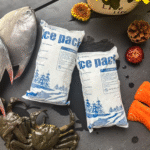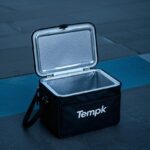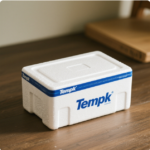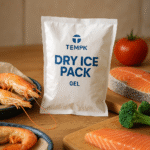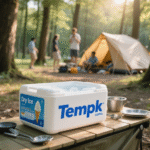Sublimation Dry Ice Packs: 2025 Guía del comprador
If you ship frozen goods in 2025, sublimation dry ice packs are your most reliable –78.5°C tool. En esta guía, you’ll learn how sublimation dry ice packs work, how many you need, and how to design pack‑outs that pass qualification without ballooning freight costs. You’ll also get 2025‑ready tips on labeling, seguridad, y sostenibilidad, so you can protect product quality and stay compliant.
-
Tamaño sublimation dry ice packs for 24–96 hours with simple rules of thumb
-
Choose materials and pack‑out patterns that improve hold time
-
Comparar sublimation dry ice packs vs gel packs vs PCM bricks for hybrid lanes
-
Navegar por 2025 regulatory labeling and dry ice documentation requirements
-
Build a validation plan that proves your shipper keeps –78.5°C cargo safe
What are sublimation dry ice packs and how do they work?
Respuesta corta: Sublimation dry ice packs are pre‑formed CO₂ blocks or pillows that maintain ultracold conditions by sublimating—turning from solid to gas—at about –78.5 °C. That phase change absorbs a large amount of heat (about 571 kJ/kg), stabilizing your payload below freezing while venting CO₂ harmlessly from the package.
Why it matters for you: Dry ice doesn’t melt into liquid water; it vents as gas. That means no leakage and no wet cartons. When engineered as modular packs, the surface area is predictable, the vent path is controlled, and pack‑outs become repeatable. For frozen biologics and seafood, sublimation dry ice packs deliver the longest hold time per kilogram among common refrigerants, provided your box can vent gas and manage pressure safely.
Sublimation rate, tener tiempo, and sizing for sublimation dry ice packs
Idea clave: Sublimation rate depends on heat leak (aislamiento + ambiente), pack shape (surface area), y apilamiento (air gaps). For a first pass, estimate required dry ice by combining heat gain and product load:
-
Heat absorbed by sublimation: ~571 kJ per kg of dry ice
-
Sensible heat of product: mass × specific heat × allowed rise
-
Heat leak: U × A × ΔT × time (or use the simple hourly W leak from your box spec)
A practical starting point:
If you don’t have a measured heat leak, use a lane-based rule of thumb for a 30–35 mm EPS shipper:
-
Mild lane (15–25°C): ~0.9–1.3 kg per 24 h per 10 L of internal volume
-
Warm lane (25–35 ° C): ~1.3–1.8 kg per 24 h per 10 L
-
Carril caliente (35–40°C): ~1.8–2.5 kg per 24 h per 10 L
Consejo: Increase load by 10–15% for door‑to‑door variability and by another 10% if your shipper sees frequent door openings.
| Typical Frozen Payload | Target Range | Suggested Refrigerant | Lo que significa para ti |
|---|---|---|---|
| mRNA vials, enzimas | ≤ –70 °C | Sublimation dry ice packs | Achieve ultracold without mechanical freezers during transit |
| Filetes de mariscos | ≤ –20 °C | Dry ice packs or PCM –21 °C | Dry ice extends shelf life vs gel; add spacers to prevent freeze-burn |
| Postres congelados | –20 °C to –10 °C | Paquetes de hielo seco (reduced mass) or PCM –18 °C | Prevent thaw cycles in last-mile peaks |
| Meat/meal kits | –18 °C target | Híbrido: gel + hielo seco | Stable outer temp with gel; dry ice handles spikes |
Consejos prácticos y sugerencias.
-
Vent path first: Always include a controlled vent. Nunca sellar herméticamente sublimation dry ice packs inside plastic with no vent.
-
Utilice espaciadores: A corrugated pad between packs and product avoids freeze-burn on direct contact.
-
Stack smart: Edge‑to‑edge perimeter “wall” plus a top layer creates a cold envelope with predictable sublimation.
-
Qualify two worst cases: Hot‑soak (35–40°C) and long dwell (96 H). If both pass, your release criteria will be simpler.
Ejemplo del mundo real: A 24‑vial biologic kit shipped with a 21 L VIP shipper and 6.0 kg of sublimation dry ice packs held below –70 °C for 96 h in a 35 °C hot‑box test, while the same payload with 30 mm EPS needed ~9.5 kg to pass. The better insulation cut refrigerant mass by ~37%.
How many sublimation dry ice packs do you need for 24–72 hours?
Respuesta corta: Sublimation dry ice packs are sized by time-in-transit and ambient severity. For 24 h at 25 °C, expect roughly 0.9–1.3 kg per 10 L internal volume. For 72 h at 35 °C, plan 4–6 kg for common 18–30 L shippers with EPS; VIP can drop that 25–40%.
Expanded view: The right amount depends on three levers you control: aislamiento, layout, and percent fill. Higher percent fill reduces voids and heat leak. Layout that wraps the payload lowers the effective surface temperature the product “sees.” Upgrading from EPS to VIP often pays back in freight: less mass, fewer cartons, and lower surcharges for CO₂ refrigerant.
Pack‑out patterns for sublimation dry ice packs
Meta: Surround the payload while maintaining CO₂ venting. Choose one:
-
Perimeter wall + top cap
-
Line all four sides with sublimation dry ice packs standing on edge; add a top cap layer.
-
Best for vials and small cartons that need uniform ultracold.
-
-
Bottom bed + perimeter + arriba
-
A thin bottom bed evens cold, perimeter keeps edges tight, top caps buffer door delays.
-
Good for food shipments to reduce freeze-burn; add a corrugated pad above the bottom bed.
-
-
Top‑heavy cap only
-
When the payload is temperature‑robust but the lane is hot, a heavy top layer counters radiant heat from above.
-
Use when time at loading bays dominates risk.
-
| Pack‑out Option | Ventajas | Contras | What to use it for |
|---|---|---|---|
| Perimeter + arriba | Most uniform cold; predictable hold time | Uses more packs | Biológicos, enzimas, deep‑frozen R&D |
| Abajo + perimeter + arriba | Gentle on product surfaces | Un poco más pesado | Mariscos, postres, premium meats |
| Top‑heavy cap | Masa más baja | Non‑uniform cold | Short flights, robust frozen SKUs |
A quick decision helper (lista de verificación interactiva)
-
Ambiente > 30 °C for ≥ 12 h? Choose perimeter + top and increase mass by 20%.
-
Payload touches pack surface? Add a 3–5 mm corrugated spacer or foam sheet.
-
Tránsito > 72 H? Add a mid‑pack belt layer or upgrade insulation to VIP.
-
CO₂ surcharge high? Model a VIP shipper; dry ice mass may drop by one‑third.
-
Customer opens on arrival? Add an extra top cap to handle hand‑off delays.
Operational case: A meal‑kit brand cut spoilage by 42% during heat waves after switching from gel‑only to hybrid sublimation dry ice packs with a top‑cap pattern, adding just 0.7 kg per box and a cardboard spacer to prevent freeze‑burn.
Sublimation dry ice packs vs gel packs vs PCM bricks: which should you choose?
Respuesta corta: Sublimation dry ice packs deliver the coldest temperature and the longest hold time per kilogram. Gel packs are best for chilled (2–8 ° C) and protect from freezing. PCM bricks serve narrow setpoints (p.ej., –21 °C or +5 °C) and reduce temperature swings.
What that means for you: If your product must stay below –20 °C—or especially below –70 °C—sublimation dry ice packs are the first choice. For mixed carts or last‑mile deliveries, a hybrid dry ice + PCM or gel pack‑out can cut total mass and improve safety at hand‑off.
When to combine sublimation dry ice packs with gel or PCM
-
Frozen desserts and seafood: Usar sublimation dry ice packs for the heavy lift and a thin gel perimeter to buffer against direct freezing on contact.
-
Long dwell + frequent door opens: Dry ice handles the peaks; PCM keeps temperatures steady when the door is closed.
-
Chilled to frozen transitions: Use PCM –21 °C around the payload and a reduced dry ice cap to extend time without overshooting to ultracold.
| Refrigerante | Fortaleza | Weakness | El mejor uso |
|---|---|---|---|
| Sublimation dry ice packs | –78.5 °C setpoint; calor latente alto | Requiere ventilación; CO₂ labeling | Deep frozen lanes, long holds |
| paquetes de gel | No hazardous label; barato | Risk of meltwater; limited cold | Chilled lanes, quick turns |
| Ladrillos PCM | Puntos de ajuste precisos | Narrow buffer; más pesado | Hybrid builds, qualification tuning |
Packaging and insulation for sublimation dry ice packs
Respuesta corta: Better insulation cuts refrigerant mass. En 2025, EPS remains the value baseline, PUR delivers stronger R‑value at moderate cost, and VIP panels provide the best performance—often allowing 25–40% less sublimation dry ice packs for the same hold time.
How to choose: Match insulation to lane and SLA. For hot lanes or 96 h holds, VIP often pays back in refrigerant savings and lower CO₂ surcharges. For short regional lanes, EPS with smart layout is enough.
Minimize heat leak with small design tweaks
-
Apriete los vacíos: Fill corners and voids with honeycomb or foam. Voids accelerate sublimation.
-
Separate inner from outer walls: Cardboard or foam standoffs reduce thermal bridging.
-
Use reflective liners: They lower radiant load, especially under hot roofs.
-
Seal flaps cleanly: Even small lid gaps can slash hold time.
| Aislamiento | Grosor típico | Relative R‑Value | Lo que significa para ti |
|---|---|---|---|
| EPS (30–35 mm) | 1.2–1.4 in | Base (1×) | El más bajo costo; heaviest dry ice needs |
| Puro (25–30 mm) | 1.0–1.2 in | ~1.6–1.8× EPS | Good mid‑tier; smaller cartons possible |
| personaje (10–20 mm) | 0.4–0.8 en | ~4–7× EPS | De primera calidad; cuts sublimation dry ice packs by 25–40% |
Regulador, seguridad, and carrier rules in 2025 for sublimation dry ice packs
Respuesta corta: Dry ice is regulated as Y 1845, Dióxido de carbono, sólido, Clase9. Sublimation dry ice packs require vented packaging, proper marking, and net‑weight disclosure. Air shipments must follow current IATA Dangerous Goods Regulations; ground carriers align with local ADR/49 CFR rules. Always check the 2025 edition relevant to your route.
Practical checklist (non‑exhaustive):
-
Calificación: Write “UN 1845, Dióxido de carbono, sólido, x kg.” Include net dry ice mass per package.
-
Ventilación: Use packaging that releases CO₂ gas. Never seal dry ice airtight.
-
Documentación: For non‑dangerous-goods cargo cooled by dry ice, include the dry ice statement on the air waybill; additional declarations may apply if cooling dangerous goods.
-
Etiquetado: Class 9 hazard label and proper size per mode.
-
Capacitación: Staff handling sublimation dry ice packs need awareness training on cold burns and CO₂ exposure.
-
Workplace safety: Provide gloves, face protection, and CO₂ ventilation in pack rooms.
Nota: Regulations update annually. Confirm limits and label sizes with your carrier’s 2025 manual before shipping.
Quality control and validation with sublimation dry ice packs
Respuesta corta: Validate with a three‑box strategy: hot‑soak worst case, long dwell, and a nominal lane. Sublimation dry ice packs should be sized to keep every probe within spec across all tests.
Execution tips:
-
Probe placement: Corners and near the lid are the hottest spots; place at least one sensor there.
-
Sampling: Use at least 10 temperature points for large payloads; 5 for small.
-
Acceptance criteria: Define product‑safe limits and maximum single‑point excursion time.
-
Data logging: Use a logger with min/max capture and clear export. Calibrate annually.
A simple pack‑out calculator you can adapt
Use this as a planning aid only—always qualify with real tests on your lane.
2025 sustainability for sublimation dry ice packs
Respuesta corta: CO₂ used for sublimation dry ice packs is often captured as a by‑product of industrial processes. En 2025, more suppliers offer reclaimed or bio‑based CO₂ sources and take‑back programs for reusable shippers, cutting total footprint without compromising hold time.
Que hacer ahora:
-
Source reclaimed CO₂: Ask suppliers how CO₂ is captured and purified.
-
Optimize mass: Upgrading insulation can reduce dry ice mass by a third, which typically lowers total emissions.
-
Right‑size cartons: Smaller dimensional weight saves fuel and money.
-
Recover materials: Use returnable carriers or partner with local dry ice vendors for reuse of totes and spacers.
2025 trends for sublimation dry ice packs
Descripción general de la tendencia: El 2025 cold‑chain market shows stronger demand for high‑reliability frozen shipping without active refrigeration. Sublimation dry ice packs benefit from three shifts: mejor aislamiento (VIP mainstreaming), smarter pack‑outs (lane‑specific designs), and compliance automation (auto‑printed UN 1845 marks and weight capture on scales). Shippers are designing for 72–96 h holds with lower mass, not just adding more CO₂.
Últimos desarrollos de un vistazo
-
VIP‑lite shippers: Thin VIP hybrids that fit parcel size limits while trimming sublimation dry ice packs by ~25–30%.
-
Auto‑weight labeling: Scales integrated with pack‑tables print the exact UN 1845 dry ice weight on the box, reducing errors.
-
Hybrid builds: Standardizing a gel + dry ice pattern for multi‑temp catalogs to simplify fulfillment training.
Insight del mercado: Frozen e‑commerce growth and biologics distribution continue to push ultracold shipments into parcel networks. Carriers maintain CO₂ handling surcharges, so leaner pack‑outs and higher fill rates are winning levers. Expect qualification to move from “pass/fail” to “pass with buffer,” where designs target ≥10% extra hold time to manage network variance.
Preguntas frecuentes
Q1: How long do sublimation dry ice packs last in transit?
Hold time depends on insulation and ambient. For 30 mm EPS at 25–35 °C, plan roughly 1.3–1.8 kg per 10 L per day. VIP reduces mass needs and extends time. Keep a 10–15% buffer.
Q2: Can sublimation dry ice packs damage my product?
Direct contact can freeze‑burn delicate foods or packaging films. Add a corrugated or foam spacer and use a perimeter wall pattern to avoid cold spots.
Q3: Are sublimation dry ice packs allowed on planes?
Sí, with conditions. Seguir 2025 IATA DGR rules for UN 1845: envasado ventilado, etiqueta de peligro, and net dry ice weight on the air waybill. Verify any weight limits with your carrier.
Q4: How do I prevent boxes from bursting?
Never seal dry ice gas tight. Provide a vent path using breathable tape or engineered vents. Avoid plastic bagging without punctures.
Q5: What’s the difference between loose dry ice and sublimation dry ice packs?
Loose pellets or blocks vary in surface area and sublimation rate. Sublimation dry ice packs are pre‑formed for repeatable behavior and cleaner handling.
Q6: Is gel enough for frozen deliveries?
For deep frozen (≤ –20 °C), gel alone usually isn’t enough for long hauls. A hybrid with sublimation dry ice packs cuts risk and often total refrigerant mass.
Q7: How do I estimate pack count quickly?
Use the lane‑based rules above or the calculator to estimate kg, then convert to your supplier’s pack size. Always validate before go‑live.
Q8: Do I need special training to use dry ice?
Sí. Train staff on cold‑burn hazards, CO₂ ventilation, etiquetado, and handling procedures. Maintain PPE and first‑aid for frostbite.
Resumen y recomendaciones
Control de llave:
-
Sublimation dry ice packs deliver reliable –78.5 °C protection with high latent heat.
-
Insulation quality and pack‑out layout drive hold time more than sheer refrigerant mass.
-
For 24–96 h lanes, start with mass per 10 L rules and validate worst‑case hot‑soak.
-
En 2025, VIP and hybrid builds reduce mass and surcharges while maintaining quality.
-
Always comply with UN 1845 labeling, desfogue, and training requirements.
Siguientes pasos:
-
Map your lanes and service‑level targets (24, 48, 72, or 96 h).
-
Prototype two pack‑outs using sublimation dry ice packs: perimeter + arriba, and bottom + perimeter + arriba.
-
Run hot‑soak qualification and tune mass by ±10–20%.
-
Document your SOP with venting and labeling steps.
-
Roll out training and audit monthly.
Llamado a la acción: Get a right‑sized pack‑out and validation checklist tailored to your lanes.
Acerca de Tempk
Tempk provides cold‑chain packaging and thermal validation solutions built for parcel and freight networks. We focus on repeatable results—clear pack‑outs, Tiempos de retención predecibles, and easy‑to‑follow SOPs. Our portfolio includes modular sublimation dry ice packs, hybrid gel/PCM kits, and insulated shippers from EPS to VIP. Two practical advantages: standardized sizes that fit carrier limits and documentation templates that make compliance fast.
Siguiente paso: Request a lane‑specific sizing worksheet and a pilot kit to verify hold time on your routes.



















